CORRECTIVE AIRWAY SURGERY
Currently, the best method for diagnosis of brachycephalic obstructive airway syndrome is a combination of:
A full physical examination
Questionnaire about current clinical signs, exercise tolerance and sleeping habits
Exercise tolerance tests such as the respiratory function grading scheme
Visual airway inspection under heavy sedation or general anaesthesia
Diagnostic imaging (e.g. Xrays)
If YOUR DOG IS DIAGNOSED WITH BOAS, Early correctiVE SURGERY is most effective at reducing the chanCe of secondary changes and laryngeal collapse, that can be life threatening.
your dog will be more comfortable following surgery, breathe more easily and be more active. BUT IT IS NOT A CURE.
My approach
-

Personalised
Our initial consultation aims to assess your dog’s current clinical signs, exercise tolerance and sleeping habits.
We will then create a personalised treatment plan and discuss risks and benefits of potential surgical intervention.
-

Targeted
If surgery is indicated based on our initial consultation, we will perform an airway assessment under general anaesthesia and address the areas of concern via multi-level airway improvement surgery.
-

Integrative
Achieving the best outcome is more than just surgery! I offer a holistic approach and this includes attention to peri-anaesthesia and post-op management.
I’ll be guiding you toward other helpful practices such as weight loss and lifestyle choices too.
If your dog is recommended to have airway surgery, the following will happen on the day of their surgery:
Blood tests are recommended to assess your dog's general health and screen for any other underlying issues.
Pre-medication is given to reduce stress, anxiety and nausea.
Your dog is then pre-oxygenated – given 100% oxygen for 10 minutes prior to anaesthesia.
Your dog will undergo a general anaesthesia
Visual airway assessment.
Radiographs (xrays) of the chest and larynx are taken to check for underlying abnormalities such as tracheal hypoplasia, soft palate thickness, pneumonia and lung pathology.
Radiographs of the hips and spine are also recommended (optional) to assess for spinal problems.
Intravenous fluids and pain relief are given throughout the anaesthetic.
Following airway assessment, we then proceed with surgical correction of abnormalities present. This is often referred to as multi-level airway improvement surgery. Some of the procedures may include:
Nares - Ala-Vestibuloplasty - parts of the nostrils and alar fold are removed to open the passage of air into the nostrils.
Soft Palate - H-pharyngoplasty - the soft palate is shortened and also thinned in cases of thick palates.
Tonsils - Tonsillectomy - Tonsils are removed if they are everted or enlarged.
Saccules - Sacculectomy - Laryngeal saccules are removed when present and obstructing the opening to the airway.
Please note there are other procedures for advanced cases.
Your pet is closely monitored for several hours after surgery. For some patients, you may be asked to be present in the post-operative recovery period to reduce stress and anxiety.
To learn more, watch the video by Dr Philip Moses explaining the benefits of multi-level corrective airway surgery.
Multi-level Corrective airway surgery
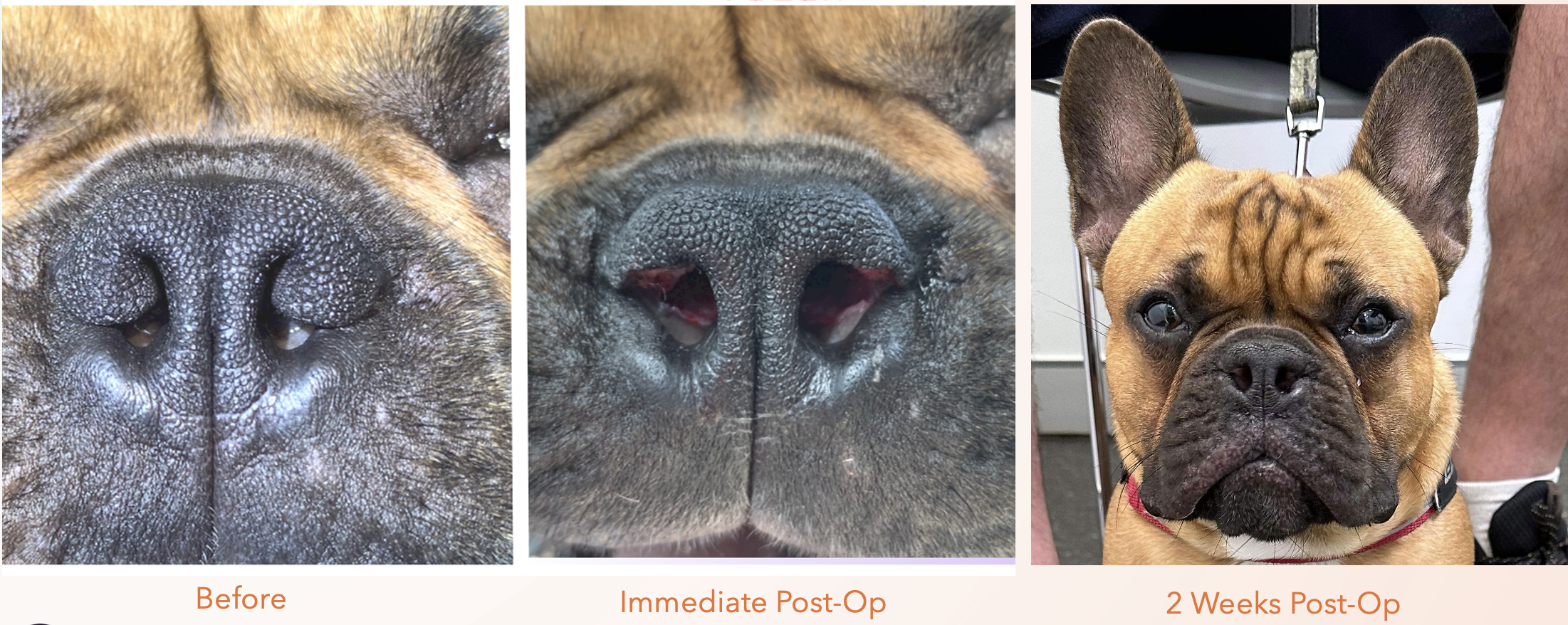
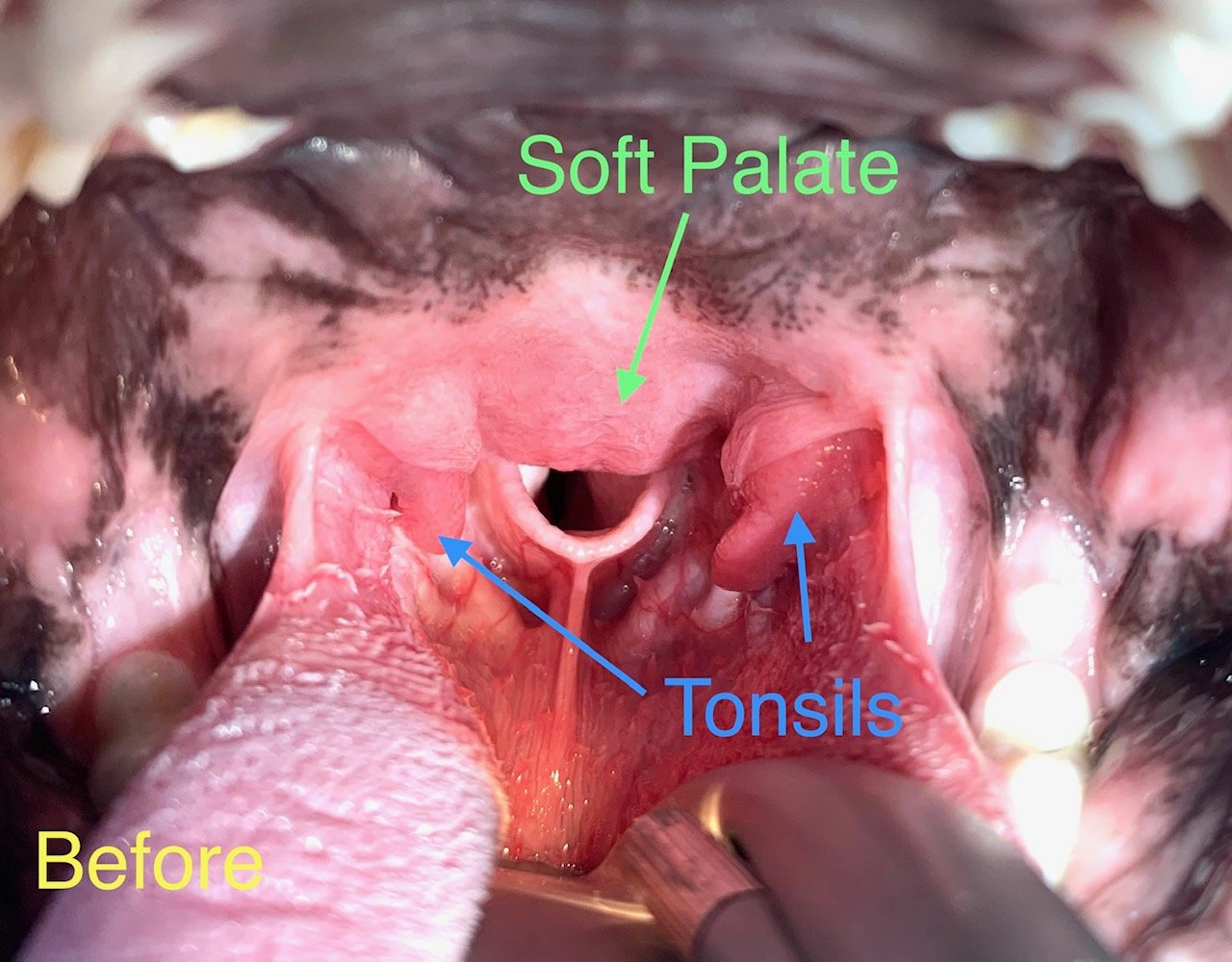
Oral Exam - Before surgery
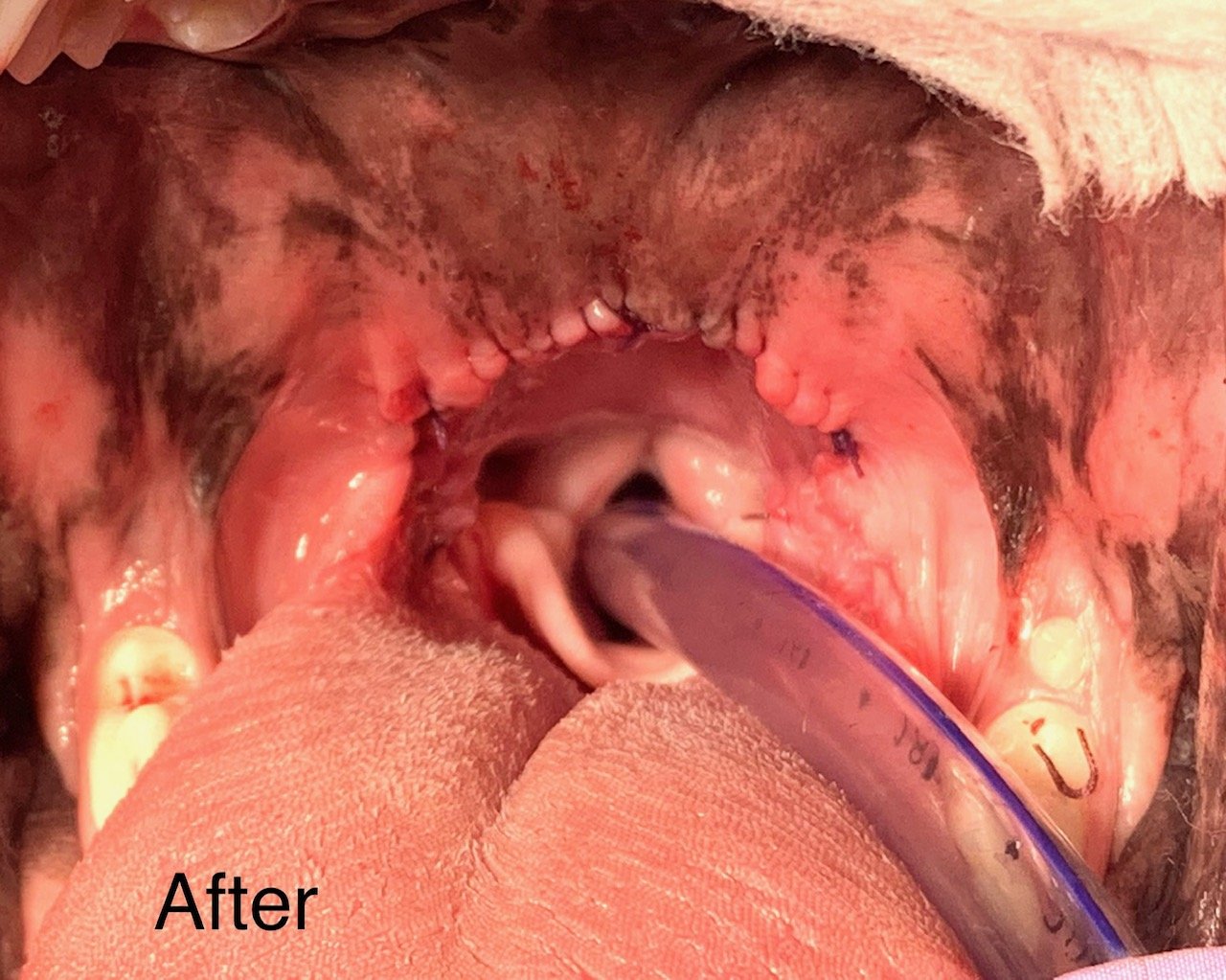
After Surgery - H-pharyngoplasty

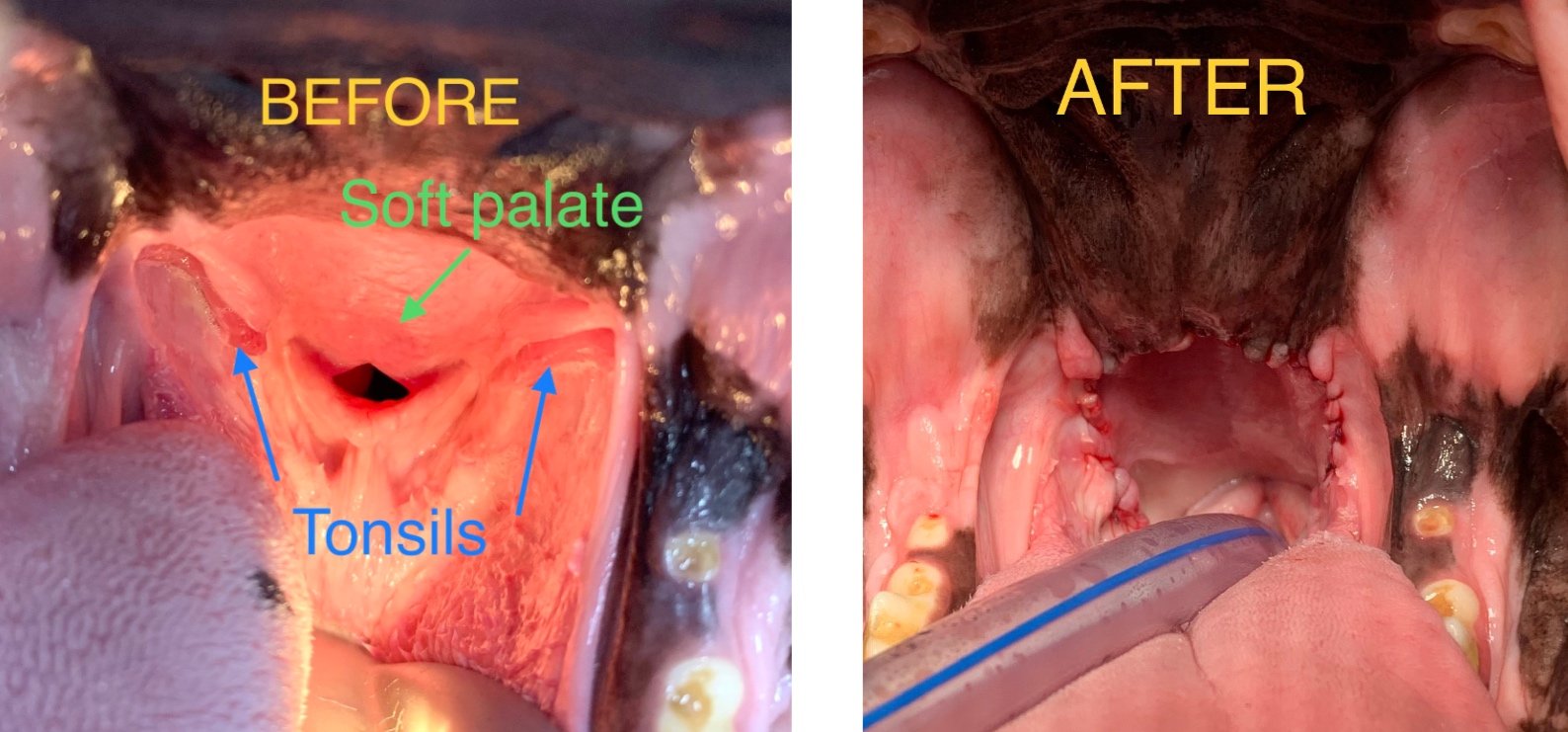
Before and After - Soft palate
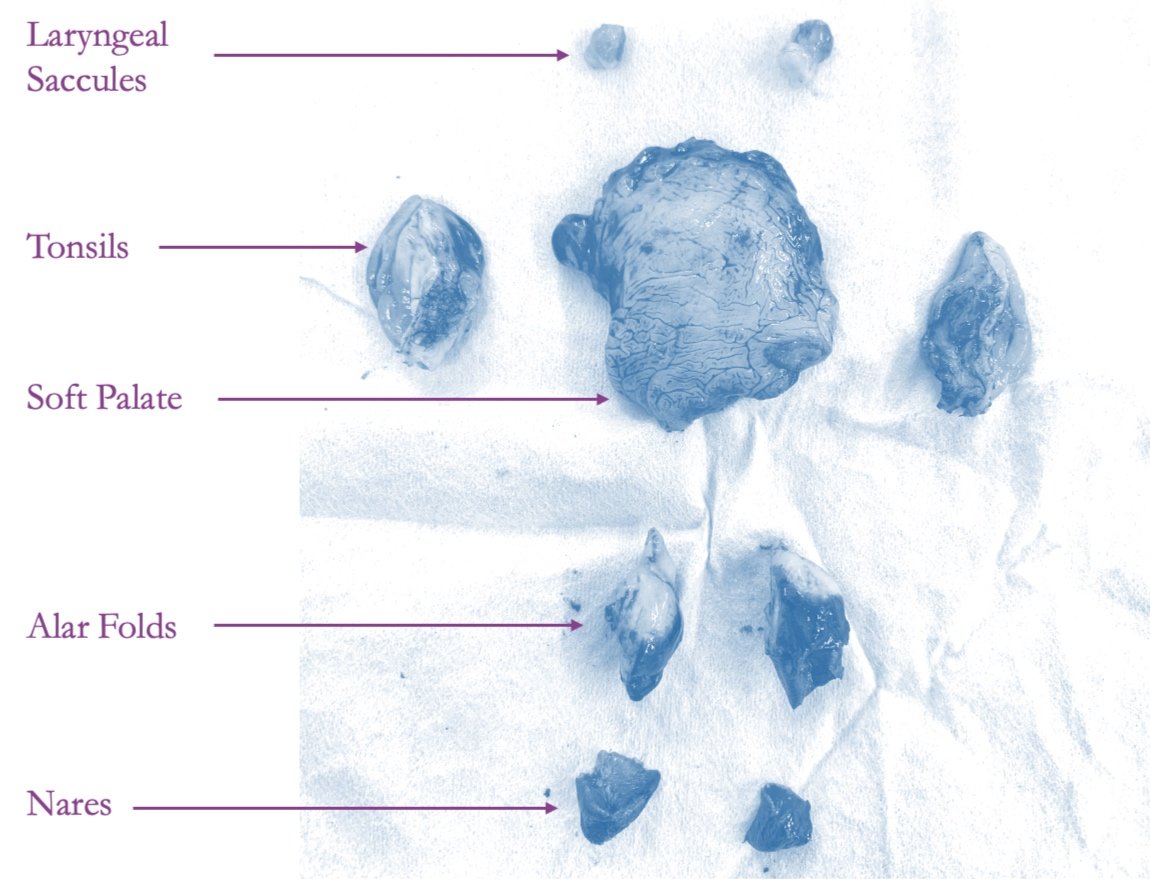
Tissues Removed in Airway Improvement Surgery
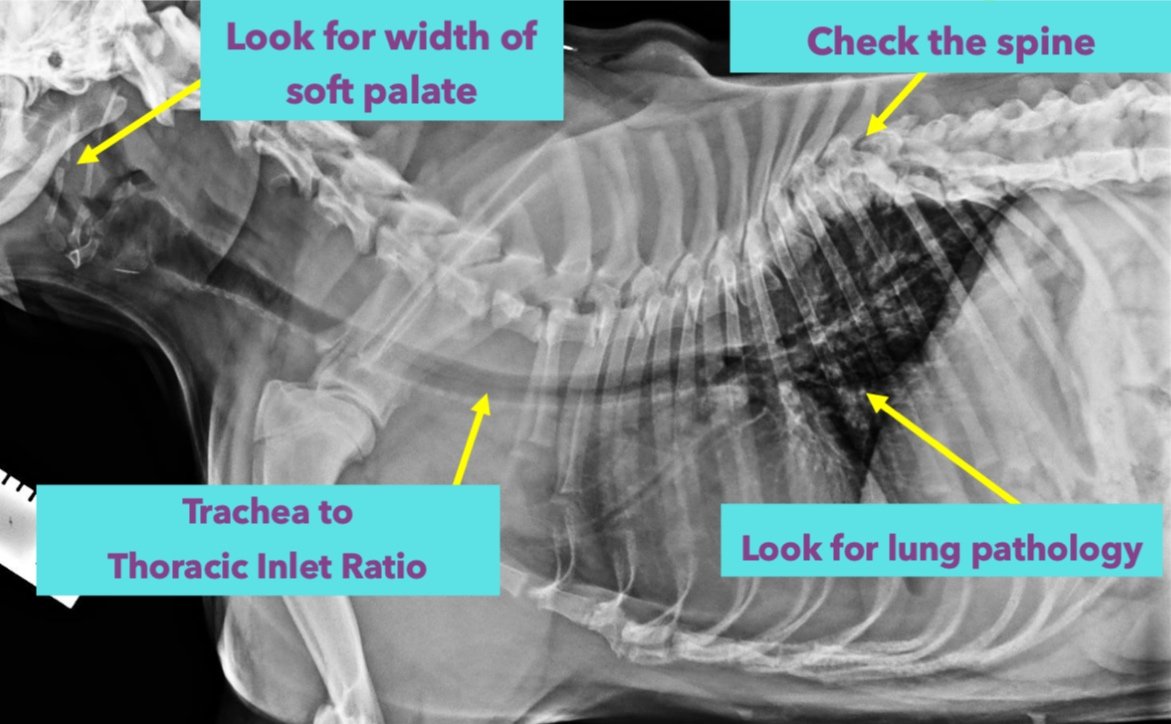
Chest radiographs
-
We will discuss this on a case by case basis in our consultation. Currently, the best method for diagnosis of brachycephalic obstructive airway syndrome is a combination of:
A full physical examination
Questionnaire about current clinical signs, exercise tolerance and sleeping habits
Exercise tolerance tests such as the respiratory function grading scheme
Visual airway inspection under heavy sedation or general anaesthesia
Diagnostic imaging (e.g. Xrays)
However some important points to consider:
EXCESSIVE RESPIRATORY NOISE FOR ANY BREED OF DOG IS NOT NORMAL
EXERCISE INTOLERANCE IS NOT NORMAL
REGURGITATION AND VOMITING IS NOT NORMAL
RESTLESS SLEEP IS NOT NORMAL
BEING “LAZY” IS NOT NORMAL
All of the above symptoms can be an indication of upper airway obstruction, and warrants further investigation.
-
If your dog is diagnosed with BOAS, early corrective surgery is most effective at reducing further secondary changes and laryngeal collapse.
The best time for most brachycephalic dogs to undergo surgery is:
French Bulldogs, Pugs, Boston Terriers - around 12 months of age.
British Bulldogs, Aussie Bulldogs, and other larger bulldogs - 12-14 months of age
-
5/5 BOAS Surgery was a term created by Melbourne Bulldog Clinic to describe 5 components of BOAS surgery that they believed to benefit their patients.
These components include:
1) Stenotic nares
2) Soft palate length
3) Soft palate thickness
4) Tonsils
5) Laryngeal Saccules
Each patient is assessed on an individual basis and there are various surgical techniques to address these components. Other surgical techniques can be considered for more advanced cases.
-
If your doggo gets stressed out when away from you (like at the vets!), provided it is safe to do so, you are welcome to be present during recovery as soon as they are waking up from their surgery.
If needed, we will use medications to help relieve stress prior to coming into the hospital. Keeping patients calm and happy is important to reduce their risk of post-operative complications.
-
Each individual is assessed on a case by case basis for their medication plan. Steroids are a type of anti-inflammatory medication that helps reduce swelling of the soft palate and tissues in the mouth. In many cases, so long as there are no other drug interactions, corticosteroids are commonly used.
Other medications include anti-nausea medications to reduce the risk of vomiting, as well as lots of pain relief, local anaesthetics and ice-blocks.
-
I currently perform surgery and consults at Erina Heights Vet Hospital on the Central Coast, NSW Australia.
Your local veterinarian is welcome to contact me for advice.
-
We are not a 24/7 hospital but overnight care is available at the local emergency hospitals (SASH and ARH) including ambulance transfer.
When it is safe to do so, many patients will go home the same day to help reduce stress and anxiety (e.g. barking, panting, pacing) that can contribute to post-op complications.
-
A tracheostomy tube is a temporary device that is placed in the windpipe to bypass the upper airway obstruction during the recovery. This is sometimes required after BOAS surgery if excessive swelling and inflammation causes an upper airway obstruction.
-
Please contact me directly so I can provide an accurate estimate for surgery (if indicated) based on your pet’s breed. Costs can vary according to clinical severity, age, breed and weight.
-
Dr Melissa is based on the Central Coast, NSW and is offering telemedicine, in-person consultations and surgical treatment of conditions commonly seen in brachycephalic breeds including:
Brachycephalic Obstructive Airway Syndrome (BOAS)
- Exercise tests and assessments
- Airway assessment
- Multi-level brachycephalic airway improvement surgery
Entropion and other eye conditions
Cork screw tail correcitve surgery
Management of chronic skin conditions and allergies
Management including surgery of skin folds
Medical management of spinal problems including intervertebral disc disease
Investigation and management of vomiting, regurgitation, reflux and flatulence
Routine health and wellness
Melissa also loves all other breeds of dogs (and cats) too!
FAQs
Improve sleep quality
Reduce snoring and respiratory noise
Reduce future anaesthetic risk
Reduce gastrointestinal signs (vomiting, regurgitation, flatulence, burping)
Improve exercise tolerance
Delay onset of advanced laryngeal collapse
Better quality of life

